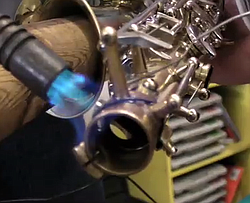Making the music last
The students took instruments apart and put them back together.
By RICK ROUAN
VINDICATOR STAFF WRITER
Instrument Repair Class

An instrument repair class at YSU's Dana School of Music. The instructor is Mark Salzman. The student speaking is Derrick Kittle.
The sounds coming from the third floor of Bliss Hall on the Youngstown State University campus weren’t typical of the Dana School of Music.
Music students had traded the nasal sound of saxophones and the chirping sound of flutes for the whoosh of a blow torch and scratch of a scraper.
About a dozen students — many of them future band directors — learned Wednesday in their final instrument-repair class to solder brackets back to instruments that had fallen into disrepair.
“I took this because, as a band director, a lot of students will come up and ask how to fix something,” said Shanna Kelly, a senior studying music education.
Students ran the gamut of learning to repair instruments over a six-week course for three days a week. They learned to take instruments apart and put them back together, how to solder pieces back to brass instruments and how to reset keys, among other lessons.
Ultimately, the class was set up to give students a rudimentary understanding of how to make a quick repair in a pinch, said Mark Salzman, the class instructor.
Salzman, who has been repairing instruments for 22 years, runs Mark Salzman Instrument Repair, 1 N. Main St., Poland.
“It takes a lot of patience,” Salzman said. “This is kind of an old-world craft.”
Students threaded horns onto table legs in a vice grip as they disassembled, cleaned and soldered french horns, trumpets and saxophones back together with a handheld torch. Some students were tentative to get close to the smoking solder, but others dived right in.
“I was really afraid that some kids would damage instruments because they are inexperienced, but it’s been good,” Salzman said.
Salzman designed the class from the bottom up, mixing lectures on how instruments work with practical application of repairing instruments in class.
“You have to understand the academic side to do the real work,” he said.
Students were responsible for assembling a tool kit, which cost about $150, to bring to class, but Salzman brought the heavy-duty tools, such as a torch and free-standing vice grip. Both Salzman and students brought in “guinea-pig instruments” to practice repairs.
Salzman said that taking the class will give students a greater appreciation for maintaining instruments as opposed to repairing them, which can prove costly.
“It’s going to give them an edge in being able to maintain an instrument,” he said. “Money is getting tight.”
That’s why Derrick Kittle is in the class.
“Especially in this economy, as a band director now, I’m going to try to help my district by doing repairs myself,” said Kittle, a master’s student who also is band director for Jackson-Milton High School.
Kittle said some districts are going to pay-to-play in bands, but that this area has been fortunate so far to not see many cuts to music programs.
“We have to pinch our pennies where we can,” said Franklin Stout, a senior studying music education.
The course isn’t a requirement for students — in fact, it’s rarely even offered — but Kelly said she jumped at the chance to take it.
“If it’s an emergency for a concert or something, hopefully I can help a student out,” she said. “It could definitely save a school some money.”
rrouan@vindy.com
 43
43
